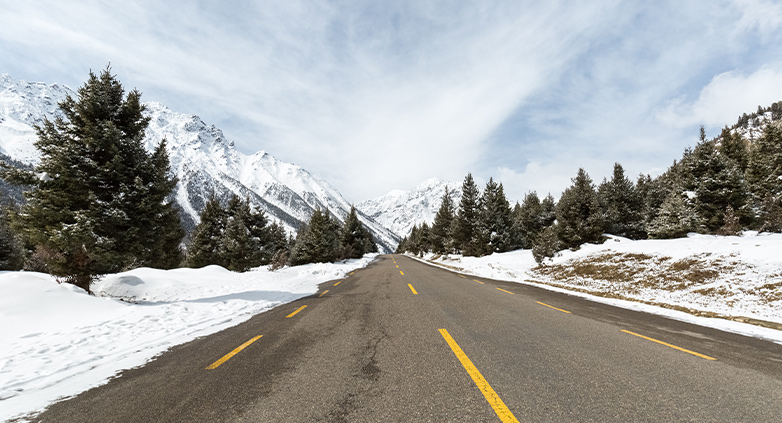All You Need to Know About Repairing Asphalt in Cold Weather
Winter’s icy grip often wreaks havoc on asphalt surfaces, leading to deterioration and costly repairs. Understanding asphalt repair in cold weather is crucial for maintaining its integrity.
Repairing asphalt in cold weather involves special techniques to address snow-induced damages like cracks and potholes. Key strategies include using cold patch asphalt, applying sealants for minor issues, and employing infrared technology for larger repairs. Regular maintenance, like snow removal and de-icing, also plays a vital role in preventing extensive damage and ensuring the longevity of your asphalt surfaces.
Discover essential tips for effectively managing asphalt repairs during cold weather. Learn about preventative measures and innovative solutions to keep your asphalt in top condition, despite winter’s challenges.
5 Things You Can And Can’t Do While Repairing Asphalt in Cold Weather
- You CAN prepare the asphalt in advance
- You CAN apply seal coating
- You CAN’T repair cracks after the temperature drops below freezing
- You CAN temporarily patch potholes during cold weather
- You CAN lay asphalt in the winter, but the ground must be dry
1. Prepare in advance to avoid repairing asphalt in cold weather
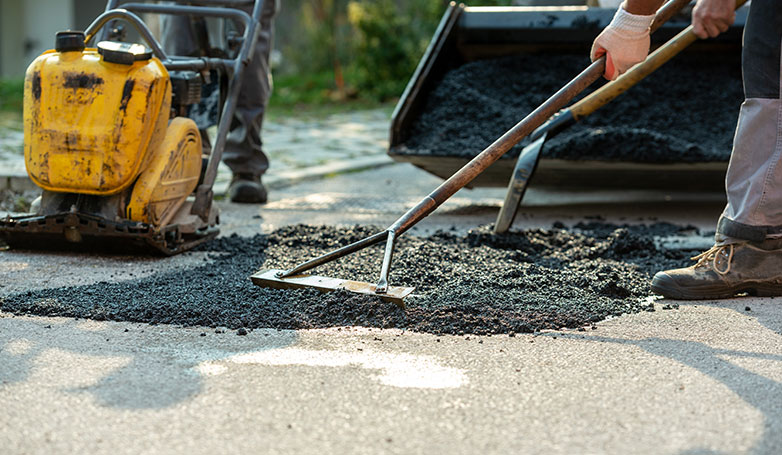
Yes, you can consider utilizing cold asphalt formulas to form temporary patches instead of just waiting for warmer weather to carry out repairs. Such temporary repairs would help prevent the cracks and potholes from growing larger and needing more costly work.
You can easily fix defects in your asphalt surfaces using cold asphalt mix before they become severe or trigger hazardous situations.
Preparing your asphalt pavement can help reduce the amount of damage that can be caused by a harsh winter. Even though cracks, potholes, and other pavement damage are unavoidable during the cold winter months, planning can help avoid serious and costly damage.
You can minimize or potentially avoid asphalt repair in cold weather if the right preparation is put in place before the chilliest months arrive.
2. Repairing asphalt in cold weather is possible

One of the key enemies of asphalt is cold weather. If water gets in your asphalt paving, it can cause contraction and expansion with temperature changes. This prompts unaddressed problems such as cracks and bumps, to become worse.
Luckily, there are options for repairing your asphalt pavement in the winter.
Although winter may not be the perfect time for some kind of driveway, roadways, or parking lot repair work for many reasons, it is possible.
It is possible to install Cold Patch Asphalt in cold weather.
Your pavement contractor can use this method to address cracks and potholes in your driveway or parking lot during the winter months.
The oils inside the cold asphalt patch keep the mixture sufficiently pliable to be used in cold temperatures. Although a cold asphalt patch does not offer a permanent solution to pavement defects, it should hold until when the climate is warm enough to make use of hot-mix asphalt.
3. You can use seal coating while repairing asphalt in cold weather

Experts have advised that seal coating should be completed during the warmer months to avoid the higher expenses involved in doing so during cold weather. Ideally, you would want to seal coat your asphalt pavement in advance of the winter season.
It will help prevent you from causing severe harm to your asphalt pavement and reduces the entire operation’s expenses to a minimum.
For the record, seal coating is not part of asphalt repair in cold weather but a protective means against the adverse winter weather.
Once winter starts, the outside temperatures will become too low to add a seal coat; therefore, it is safer to have asphalt cracks sealed before it gets chilly.
Because once the temperature drops below freezing, water will seep through asphalt pavement cracks where it expands. So, it is ideal to have asphalt cracks seal-coated long before the temperature dips below 30°F.
Temperatures below 50 °F are too chilly for a seal coat to be applied. In addition, if the low temperature still drops to freezing or lower, as the coating is getting dried, the water inside the seal coat material could freeze, resulting in separation and peeling of the finished piece.
May through September are the best months for seal coatings.
Because the seal coat material can not be used during winters, most manufacturing companies usually shut down in the winter. Seal coating your pavement before the winter months will keep it protected and also give your asphalt a new-like look.
4. Filling cracks earlier in the year will help avoid repairing asphalt in cold weather
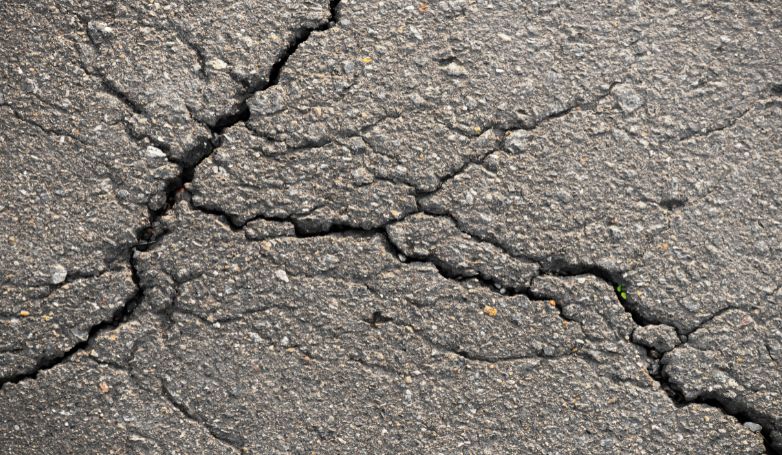
It is possible to carry out crack filling during the winter season, but the surface must be dry.
Pavement cracks contract in the summertime, so it is truly best to have asphalt cracks filled before the colder weather sets in and cracks become widened with the cold.
However, we suggest that all cracks be filled before the start of winter, as it is much harder to get it done during the colder months. Although asphalt repair in cold weather is challenging, it is possible.
During this maintenance procedure, you are required to clean, blow out, and fill cracks using one of the various varieties of emulsions, cement, or asphalt alternatives that prevent water infiltration.
Cracks usually start small, and when you spot them, try to get them fixed immediately to avoid water creeping into the base of your pavement.
5. Potholes can be fixed while repairing asphalt in cold weather
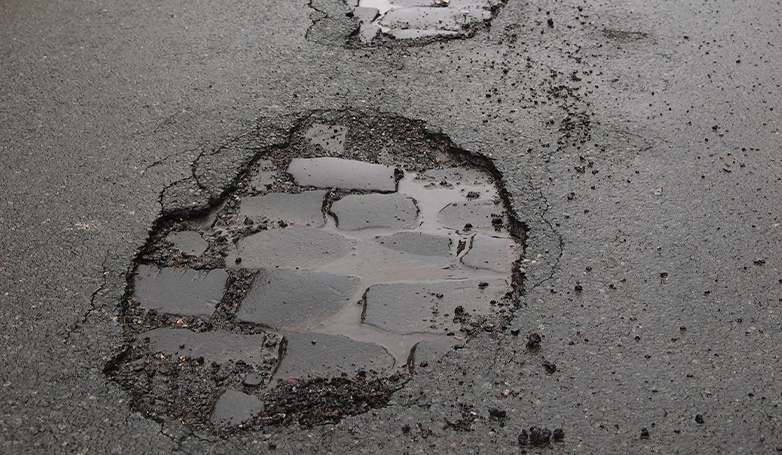
Yes, during the dead of winter, your asphalt surface contractor can temporarily repair potholes using a cold asphalt patch until the weather is warm enough for a parking lot or driveway paving.
You’ll be able to employ a paving contractor to cover potholes and gaps once the snow melts.
Such temporary fixes can help prevent the potholes and cracks from getting bigger and needing more costly work.
The cold asphalt mix is a great short-term fix for potholes, especially in cold weather, when it is impossible to apply other types of asphalt.
How to deal with repairing asphalt in cold weather
Ignoring winter asphalt maintenance is all too easy, but it doesn’t take much time to repair potholes, saving you a good deal of money in the long run.
Conducting asphalt repair in cold weather, especially cracks and potholes filling, is a daunting task.
Still, if you leave a hole in your pavement without fixing it, it lets ice and water get in to erode even more of the asphalt and its base, allowing for a very costly spring repair or replacement.
Cold patch asphalt is an ideal alternative for cold-weather applications. It is composed of bitumen binder and aggregate that is specially formulated for heat-free mixing and curing.
It is easy to use cold patch asphalt and does not require any pricey, fancy equipment, so it is something that you can easily complete yourself or contact a professional to get it done for you.
Below are a few steps you can observe to address asphalt cracks or potholes using cold asphalt patch in the winter:
- Get debris and ice cleared out. If there is any trash or chunks of ice, take them out. As you know, if you leave blocks of ice, as it melts, it creates an air pocket and a crumbling, sinking fixing work when spring comes.
- If you can, aim for straight-up-and-down edges of the pothole and chisel them, turning the hole into a square so you can get the perfect outcome as you patch.
- Add rough gravel and compress to fix the base, if the hole has soft spots and is more in-depth than 2 inches. Maintenance or asphalt repair in cold weather doesn’t mean that you can forget the fundamentals of protecting your blacktop’s foundation.
- The next step is to add the asphalt cold patch. It will quickly set hard as a rock in the pothole. You may opt to overfill the area to make the next step easier.
- The last step here is tramping down and compacting the cold asphalt patch you poured into the hole. If a vibrating plate is not available, you can simply place plywood over the area and drive over it.
How to prepare your surface to avoid repairing asphalt in cold weather
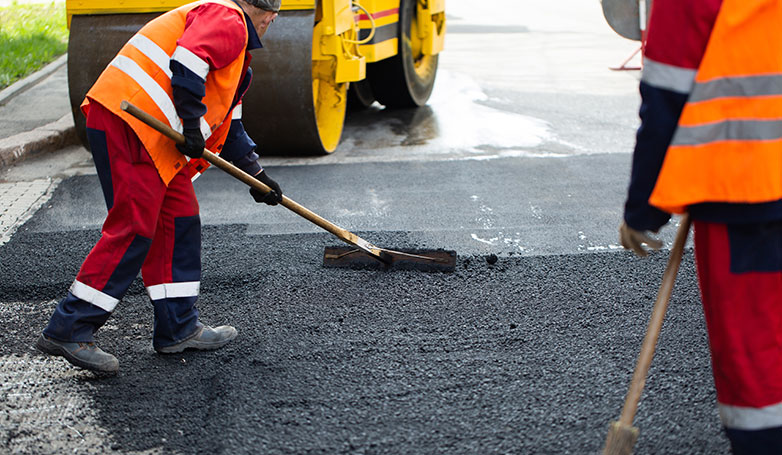
You need to keep ahead of the game employing preventive maintenance as the winter months approach. By observing a few simple preventative maintenance steps before the temperature drops, you can help extend the life and integrity of your asphalt pavement.
There is a need to draw up a plan of action regarding the maintenance of your asphalt pavement to make your property keep looking fabulous even after the winter season.
If you take a little time out of your schedule to ready your asphalt against the cold winter weather ahead, it will help to preserve your asphalt and prolong its service life.
Below are the things you need to do to prepare your pavement surface against the winter months:
- Ensure all debris is cleared off your parking lots and driveways, ensuring that snow can be removed correctly and safely.
- Buy good quality shovels for your business or home to guarantee that ice and snow can be cleared away on time and safely. Again, do not buy shovels with overly sharp edges that could crack, chip, or cause further damage to the pavement.
- If your asphalt has potholes, it is necessary to have them fixed as soon as possible.
- Be cautious if you see water pooling on your driveway or parking lot. You need to be conscious of it as it might result in potholes. It is important to rectify any defective areas of your pavement as quickly as possible.
- If your asphalt pavement has cracks, fill them up to prevent water from making its way under the asphalt surface and compromising the sub-base.
- Wash off any oil and rubber build-up from vehicles that have been in and out of your parking lot or driveway during the summertime, spring, and fall. Use a mild detergent with a pressure washer to clean your pavement to prepare it for winter.
- Trim any shrubs or bushes which may sprout near your paved driveway or sidewalk. This is good for the plants and is also an important step to follow to get your asphalt prepared for winter.
- Another method to consider before winter arrives is a seal coating. In this procedure, a protective barrier is placed over the asphalt. This thin layer protects the asphalt pavement against the adverse effects of weather, chemicals, UV light, oil, and other elements. Sealcoating is a highly recommended method you can adopt to shield your pavement if you want to avoid asphalt repair in cold weather.
Can asphalt be laid in the winter?

Ideally, the surface needs to be dry before installing an asphalt parking lot or driveway paving. This cannot be done during snow or rain. The ground must be wholly dry, which precludes asphalt paving immediately after it rains or in the winter.
What professional paving contractors usually consider first is the ground temperature of the base for the asphalt.
This is the most significant factor when it comes to installing fresh asphalt pavement.
Generally, asphalt can not be installed when the ground temperature is below freezing. A cold base triggers the asphalt to lose its heat, making it virtually impossible to achieve sufficient compaction.
New asphalt installation is not feasible if the ground is frozen owing to the above-highlighted issue. Experts advise that you postpone every paving project until late spring or summertime when the worst of the freezing temperatures have receded, and the ground starts to thaw, and the environmental conditions become dry.
The effect of winter on pavement

The cold winter weather can have a detrimental impact on your asphalt. During the winter season, unanticipated elements and cold weather can negatively impact the asphalt. Constant freeze-thaw cycles can result in significant damage to the asphalt pavement.
How do freeze/thaw cycles impact your pavement?
The freezing and thawing cycle is a point at which the temperature fluctuates between below freezing and above freezing (32F).
Snowmelt and rainwater will find their way through every tiny crack in the asphalt pavement when temperatures are above zero. Then the water inside the cracked asphalt pavement starts to freeze and expand as temperatures fall below zero, prompting the crack’s expansion and growth.
Asphalt repair in cold weather is usually practiced by many homeowners, especially when the freeze/thaw cycle effect becomes too apparent during the winter season.
When water becomes frozen, it expands by about 10 percent and has been measured to exert more than 30,000 psi as it expands. There is no way to stop the freezing water from causing damage to the pavement from the inside out.
Finally, the ice is re-melted by warming weather, enabling the water to move pretty deep into the newly expanded crack, causing it to freeze and expand in the next cycle.
Sadly, freezing and thawing can do more than making cracks expand.
Water below the asphalt pavement is supposed to flow away, but it freezes in the foundation and subgrades materials during the winter months. Freezing water underneath the pavement can often cause the occurrence of a frost heave.
Is it possible to perform seal coating after a crack filling?
Sure. Seal coating covers the asphalt pavement, protecting it from oxidation and erosion of the pavement top layer. Once you have filed the asphalt cracks, the two materials will bond.
Due to the reason that cracks sealing material are formulated to contract and expand via a wide range of temperatures, seal coats can chip away from the crack filling material.
There is also a color variation between the two materials; hence, you can say whether another layer of seal coat needs to be added to blend the two in a crack-filled portion.
Conclusion
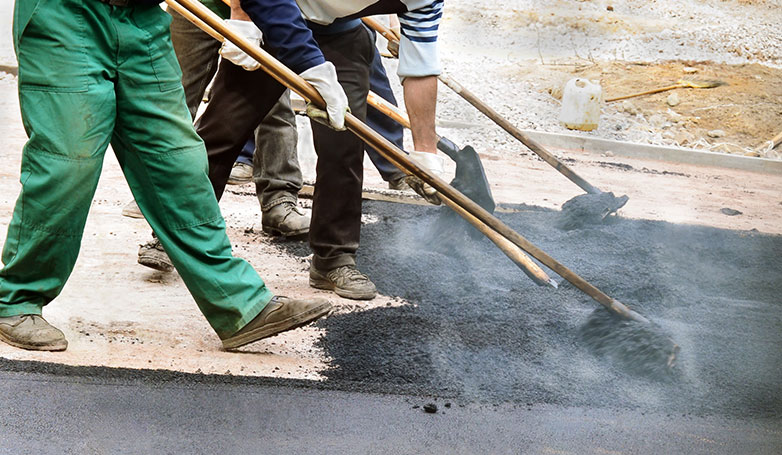
When it comes to asphalt repair in cold weather, proper care should be taken so you don’t do what would result in more severe damage to your pavement.
In essence, cold weather does not play well with asphalt, but with patience and the right paving professional, you can make things work properly.
It is possible to carry out asphalt maintenance if there is no precipitation in the forecast, temperatures are warm, and your local professional paving contractor gives you the go-ahead. If your asphalt project can not wait and the weather condition allows it, you can seek expert advice and proceed to complete it.
If the cold winter weather becomes severe, you can schedule any form of repair/maintenance work for late spring when temperatures are favorable.
In a nutshell, during the winter months, it is highly recommended to postpone any paving project as the desired best result cannot be achieved during this period. It may lead to other damage in your asphalt that can cause you more costly repair.

